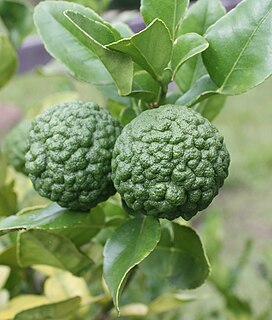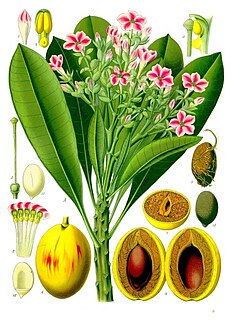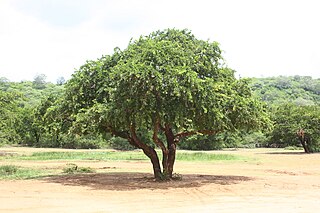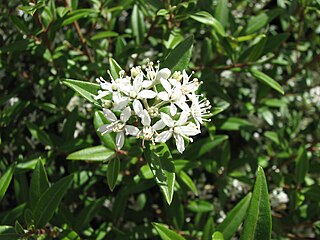
Ebony is a dense black/brown hardwood, coming from several species in the genus Diospyros, which also contains the persimmons. Unlike most woods, ebony is dense enough to sink in water. It is finely textured and has a mirror finish when polished, making it valuable as an ornamental wood. The word ebony comes from the Ancient Egyptian hbny, through the Ancient Greek ἔβενος, into Latin and Middle English.

Citrus hystrix, called the kaffir lime or makrut lime, is a citrus fruit native to tropical Southeast Asia.

Catharanthus is a genus of flowering plants in the family Apocynaceae. Like the genus Vinca, they are known commonly as periwinkles. There are eight known species. Seven are endemic to Madagascar, though one, C. roseus, is widely naturalized around the world. The eighth species, C. pusillus, is native to India and Sri Lanka. The name Catharanthus comes from the Greek for "pure flower".

Hyphaene is a genus of palms native to Africa, Madagascar, the Middle East, and the Indian subcontinent.

Olea is a genus of about 40 species in the family Oleaceae, native to warm temperate and tropical regions of the Middle East, southern Europe, Africa, southern Asia, and Australasia. They are evergreen trees and shrubs, with small, opposite, entire leaves. The fruit is a drupe. Leaves of Olea contain trichosclereids.

Cerbera is a genus of evergreen small trees or shrubs, native to tropical Asia, Australia, Madagascar, and various islands in the Indian Ocean and the western Pacific Ocean.

Zanthoxylum is a genus of about 250 species of deciduous and evergreen trees, shrubs and climbers in the family Rutaceae that are native to warm temperate and subtropical areas worldwide. It is the type genus of the tribe Zanthoxyleae in the subfamily Rutoideae. Several of the species have yellow heartwood, to which their generic name alludes.

Margaritaria is a plant genus of the family Phyllanthaceae first published as a genus in 1782. It is the smallest pantropical genus of the Phyllanthaceae and, formerly, of the Euphorbiaceae, widely distributed in tropical and subtropical regions of Asia, Africa, Australia, North and South America, and various oceanic islands.

Chloroxylon swietenia, the Ceylon satinwood or East Indian satinwood, is a tropical hardwood, the sole species in the genus Chloroxylon. It is native to southern India, Sri Lanka, and Madagascar.

Professor David John Mabberley, is a British-born botanist, educator and writer. Among his varied scientific interests is the taxonomy of tropical plants, especially trees of the families Labiatae, Meliaceae and Rutaceae. He is perhaps best known for his plant dictionary The plant-book. A portable dictionary of the vascular plants. The third edition was published in 2008 as Mabberley's Plant-book, for which he was awarded the Engler Medal in Silver in 2009. As of June 2017 Mabberley's Plant-book is in its fourth edition.

Allocasuarina torulosa, the rose she-oak or forest oak, is a tree which grows in sub-rainforest of Queensland and New South Wales, Australia. There, it is typically found on coastal footslopes, hills, and plains. Originally described as Casuarina torulosa by William Aiton, it was moved to its current genus in 1982 by Australian botanist Lawrie Johnson. It is the type species of the genus Allocasuarina.

Limonia acidissima is the only species within the monotypic genus Limonia. Common names for the species in English include wood-apple and elephant-apple.
Thomas Gordon Hartley was an American botanist.

Neolamarckia cadamba, with English common names burflower-tree, laran, and Leichhardt pine, and called kadam or cadamba locally, is an evergreen, tropical tree native to South and Southeast Asia. The genus name honours French naturalist Jean-Baptiste Lamarck. It has scented orange flowers in dense globe-shaped clusters. The flowers are used in perfumes. The tree is grown as an ornamental plant and for timber and paper-making. Kadam features in Indian religions and mythologies.
Wildlife of Sri Lanka includes its flora and fauna and their natural habitats. Sri Lanka has one of the highest rates of biological endemism in the world.

Nematolepis squamea , commonly known as Satinwood, is an upright shrub or small tree species which is endemic to Australia.

Petchia is a genus of plant in the family Apocynaceae, first described as a genus in 1926. It is native to Madagascar, Cameroon, the Comoros and Sri Lanka.
- Petchia africanaLeeuwenb. - Cameroon
- Petchia ceylanica(Wight) Livera - Sri Lanka
- Petchia cryptophlebia(Baker) Leeuwenb. - Madagascar
- Petchia erythrocarpa(Vatke) Leeuwenb. - Comoros, Madagascar
- Petchia humbertii(Markgr.) Leeuwenb. - Madagascar
- Petchia madagascariensis(A.DC.) Leeuwenb. - Madagascar
- Petchia montana(Pichon) Leeuwenb. - Madagascar
- Petchia plectaneiifolia(Pichon) Leeuwenb. - Madagascar















